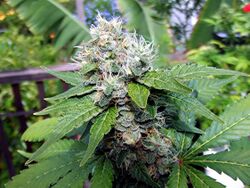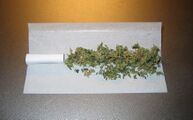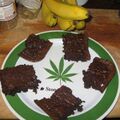Cannabis: Difference between revisions
>Josikins |
>Josikins |
||
| Line 103: | Line 103: | ||
==Legal Issues== | ==Legal Issues== | ||
[[File:World-cannabis-laws.png|thumb| | [[File:World-cannabis-laws.png|thumb|left|600px|Map showing cannabis laws world wide.]] | ||
==See Also== | ==See Also== | ||
Revision as of 12:52, 18 April 2014
 |
This article is a stub. As such, it may contain incomplete or wrong information. You can help by expanding it. |
{{#setlogo:SmallStonedStare.gif}}
Cannabis, also known as marijuana[1], weed[2], pot[3], grass[4], herb[5] and by numerous other names, is a preparation of the cannabis plant intended for use as a psychoactive drug and as medicine.[6][7] Pharmacologically, the principal psychoactive constituent of cannabis is tetrahydrocannabinol (THC); it is one of 483 known compounds in the plant,[8] including at least 84 other cannabinoids, such as cannabidiol (CBD), cannabinol (CBN), tetrahydrocannabivarin (THCV),[9][10] and cannabigerol (CBG).
Contemporary uses of cannabis are as a recreational or medicinal drug, and as part of religious or spiritual rites; the earliest recorded uses date from the 3rd millennium BC.[11] Since the early 20th century cannabis has been subject to legal restrictions with the possession, use, and sale of cannabis preparations containing psychoactive cannabinoids currently illegal in most countries of the world; the United Nations has said that cannabis is the most-used illicit drug in the world.[12][13] In 2004, the United Nations estimated that global consumption of cannabis indicated that approximately 4% of the adult world population (162 million people) used cannabis annually, and that approximately 0.6% (22.5 million) of people used cannabis daily.[14]
Chemistry
Pharmacology
Subjective effects
Physical effects
- Spontaneous tactile sensations - The body high of cannabis is extremely variable in both its style and intensity. It depends entirely on the individual strain of plant and does not manifest itself consistently. In general however it can be described as a pleasurable, warm, soft, and all-encompassing glowing tingling sensation. It maintains a consistent presence that quickly rises with the onset and hits its limit once the peak has been reached before immediately dissipating.
- Sedation - Although certain strains of cannabis present mild encouraged stimulation at low to moderate dosages, for the most part the effects on the users energy levels are primarily sedating. This encourages one to relax but can however be suppressed by simply forcing oneself to engage in physical activities.
- Loss of motor control - This substance causes a partial to moderate suppression of motor control which intensifies proportional to dosage but rarely results in a complete inability to walk and perform basic movements.
- Appetite stimulation - The feeling of increased appetite following the use of cannabis has been documented for hundreds of years[15] and is known colloquially as "the munchies" in popular American and United Kingdom culture. Clinical studies and survey data have found that cannabis increases food enjoyment and interest in food.[16] This is thought to be due to the way in which endocannabinoids in the hypothalamus activate cannabinoid receptor that are responsible for maintaining food intake.[17]
- Nausea suppression - Cannabis is effective for suppressing nausea induced by both general illness and substance induced nausea. It is considered an effective treatment for chemotherapy induced nausea and vomiting (CINV)[18] and is a reasonable option in those who do not improve following preferential treatment.[19]
- Dehydration
- Vasodilation - THC decreases blood pressure which dilates the blood vessels and increases blood flow throughout the body. The arteries in the eyeball expand from the decreased blood pressure. Studies in the 1970s showed marijuana, when smoked or eaten, effectively lowers intraocular pressure by about 25%, as much as standard medications.[20] These enlarged arteries often produce a bloodshot red eye effect. It is precisely this effect on the human eye that makes cannabis an effective medicine for glaucoma.[21]
- Pain relief - This substance has been reported as useful for treating certain headaches, chronic pain, including pain caused by neuropathy and possibly fibromyalgia and rheumatoid arthritis.[22][23]
- Increased bodily weight or Decreased bodily weight - Depending on the specific strain of cannabis, one can find themselves with a body which can feel either physically heavier or lighter than it usually would in a style that is entirely dependent upon dosage.
- Changes in gravity - At extremely high dosages many users report a feeling of being pulled backwards across vast distances at powerful speeds. This sensation progressively increases in intensity and eventually becomes unbearable if one leans backwards or lies down but disappears altogether once the user sits up or leans forward.
Cognitive effects
- Enhancement of current mindstate - The most prominent cognitive component of the cannabis experience is the way in which it enhances the emotions one is already feeling proportional to dosage. This can result in euphoria, extreme laughter, increased immersion within tasks and activities or it can result in anxiety or paranoia depending on the users current mind state.
- Connectivity of thought
- Thought deceleration
- Conceptual thinking
- Mindfulness
- Suppression of information processing
- Suppression of dreaming - It is commonly reported that regular cannabis use before sleep results in a complete absence of dreams but a day or two of abstaining from cannabis results in an intensification of dreams for a short period of time. This claim is supported through studies that demonstrate that measurably reduced eye movement activity and REM states occur when one falls asleep in the THC condition. This state is strongly associated with dreaming. The same study also reported a REM rebound effect, that is more REM activity, on withdrawal from THC.[24]
- Anxiety
- Paranoia
Visual effects
- Enhancement of colour
- Decreased visual acuity
- Geometry - cannabis is capable of inconsistently inducing mild psychedelic geometry at extremely high dosages within many users. Within users who also regularly use psychedelics however it is capable of inducing these consistently in a visual style which seems to be an averaged out depiction of all the psychedelics one has used within the past. These rarely extend beyond level 4 and are considered to be mild, fine, small and zoomed out but often well defined.
Auditory effects
Combinational effects
- Psychedelics - when used in combination with psychedelics, cannabis is capable of intensifying and extending the duration of both the visual and cognitive effects with extreme efficiency. This should be used with caution if one is not experienced with psychedelics.
- Dissociatives - when used in combination with dissociatives the geometry, euphoria, dissociation and hallucinatory effects are often greatly enhanced.
- Alcohol - when used in combination with alcohol, cannabis often creates feelings of extreme nausea, dizziness and changes in gravity. It is recommended that one smokes before drinking and not the other way around unless they are extremely cautious.
Methods of consumption
Cannabis is consumed in many different ways:[25]
- Smoking, which typically involves inhaling vaporized cannabinoids ("smoke") from small pipes, bongs (portable versions of hookahs with water chamber), paper-wrapped joints or tobacco-leaf-wrapped blunts, roach clips, and other items.[26]
- Vaporizer, which heats herbal cannabis to 165–190 °C (329–374 °F),[80] causing the active ingredients to evaporate into a vapor without burning the plant material (the boiling point of THC is 157 °C (315 °F) at 760 mmHg pressure).[27]
- Cannabis tea, which contains relatively small concentrations of THC because THC is an oil (lipophilic) and is only slightly water-soluble (with a solubility of 2.8 mg per liter).[28] Cannabis tea is made by first adding a saturated fat to hot water (e.g. cream or any milk except skim) with a small amount of cannabis.[29]
- Edibles, where cannabis is added as an ingredient to one of a variety of foods.
-
A joint/spliff prior to rolling, with a paper handmade filter on the left.
-
A forced-air vaporizer. The detachable balloon (top) fills with vapors that are then inhaled.
-
Edible weed brownies.
Toxicity and Harm Potential
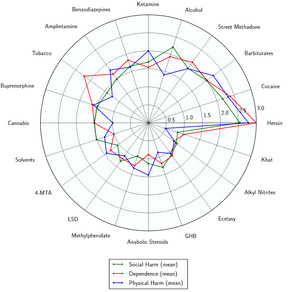
Lethal Dosage
Tolerance and Addiction Potential
Legal Issues
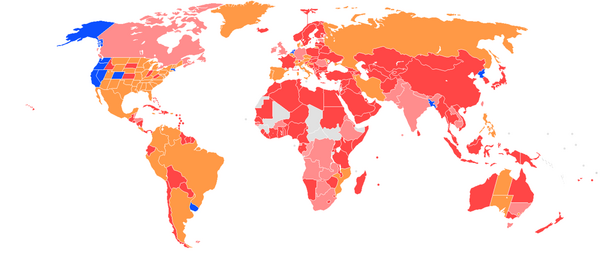
See Also
References
- ↑ http://en.wikipedia.org/wiki/Marijuana_(word)
- ↑ http://www.merriam-webster.com/dictionary/weed
- ↑ http://www.merriam-webster.com/dictionary/pot
- ↑ http://www.merriam-webster.com/dictionary/grass
- ↑ http://www.merriam-webster.com/dictionary/herb
- ↑ Shorter Oxford English Dictionary (6th ed.), Oxford University Press, 2007, ISBN 978-0-19-920687-2
- ↑ Editors of the American Heritage Dictionaries (2007). Spanish Word Histories and Mysteries: English Words That Come From Spanish. Houghton Mifflin Harcourt. p. 142. ISBN 978-0-547-35021-9.
- ↑ Ethan B Russo (2013). Cannabis and Cannabinoids: Pharmacology, Toxicology, and Therapeutic Potential. Routledge. p. 28. ISBN 978-1-136-61493-4. | http://books.google.co.uk/books?id=qH-2Lj9x7L4C&pg=PP28&redir_esc=y#v=onepage&q&f=false
- ↑ Antidepressant-like effect of ?9-tetrahydrocannabinol and other cannabinoids isolated from Cannabis sativa L | http://www.ncbi.nlm.nih.gov/pmc/articles/PMC2866040/
- ↑ Distinct Effects of ?9-Tetrahydrocannabinol and Cannabidiol on Neural Activation During Emotional Processing | http://archpsyc.jamanetwork.com/article.aspx?articleid=482939
- ↑ 13.Jump up ^ Martin Booth (2003). Cannabis: A History. Transworld. p. 36. ISBN 978-1-4090-8489-1.
- ↑ http://www.erowid.org/plants/cannabis/cannabis_law.shtml
- ↑ http://www.unodc.org/unodc/en/data-and-analysis/WDR-2010.html
- ↑ http://www.unodc.org/pdf/WDR_2006/wdr2006_chap2_biggest_market.pdf
- ↑ Mechoulam, R. (1984). Cannabinoids as therapeutic agents. Boca Raton, FL: CRC Press. ISBN 0-8493-5772-1.
- ↑ How Marijuana Works | http://science.howstuffworks.com/marijuana4.htm
- ↑ How Marijuana Works | http://science.howstuffworks.com/marijuana4.htm
- ↑ The Pharmacologic and Clinical Effects of Medical Cannabis | http://onlinelibrary.wiley.com/doi/10.1002/phar.1187/abstract;jsessionid=1E004D7B7E2B5CA792E75A6E83EEC59C.f03t01
- ↑ The Therapeutic Potential of Cannabis and Cannabinoids | http://www.aerzteblatt.de/int/archive/article?id=127603
- ↑ Cardiovascular Effects of Cannabis | http://www.idmu.co.uk/canncardio.htm
- ↑ Is Marijuana an Effective Treatment for Glaucoma? | http://medicalmarijuana.procon.org/view.answers.php?questionID=000140
- ↑ Systematic Review and Meta-analysis of Cannabis Treatment for Chronic Pain | http://onlinelibrary.wiley.com/doi/10.1111/j.1526-4637.2009.00703.x/abstract
- ↑ Cannabinoids for treatment of chronic non-cancer pain; a systematic review of randomized trials | http://onlinelibrary.wiley.com/doi/10.1111/j.1365-2125.2011.03970.x/abstract
- ↑ Feinberg, I., Jones, R, Walker JM, Cavness, C, March, J. (1975). Effects of high dosage delta-9-tetrahydrocannabinol on sleep patterns in man. Clin Parmacol Ther. 1975; 17(4):458-66.
- ↑ The Cultural/Subcultural Contexts of Marijuana Use at the Turn of the Twenty-First Century | http://books.google.co.uk/books?id=KFMtFv2tmbYC&pg=PA82&redir_esc=y#v=onepage&q&f=false
- ↑ Allan Tasman; Jerald Kay; Jeffrey A. Lieberman; Michael B. First, Mario Maj (2011). Psychiatry. John Wiley & Sons. p. 9. ISBN 978-1-119-96540-4. | http://books.google.co.uk/books?id=vVG7zz7eaxcC&pg=RA9-PT2217&redir_esc=y#v=onepage&q&f=false
- ↑ Cannabis and Cannabis Extracts: Greater Than the Sum of Their Parts? | http://www.cannabis-med.org/data/pdf/2001-03-04-7.pdf
- ↑ Dronabinol | http://chem.sis.nlm.nih.gov/chemidplus/rn/1972-08-3
- ↑ Marijuana medical handbook | http://books.google.co.uk/books?id=OuAHxDKcpS8C&pg=PA182&redir_esc=y#v=onepage&q&f=false
- ↑ Development of a rational scale to assess the harm of drugs of potential misuse | http://www.sciencedirect.com/science/article/pii/S0140673607604644
